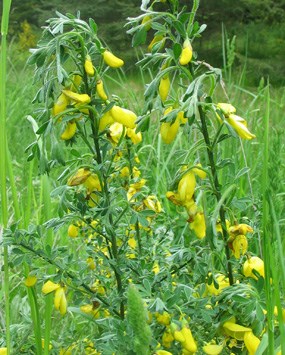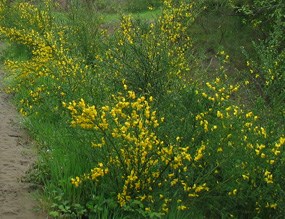
and three-part leaves. NPS Exotic Plant Management Team Cytisus scoparius This shrub has bright yellow flowers that grow into pea pod-like fruits. It is often seen in fields or alongside roads. It is widely distributed throughout the Pacific Northwest on disturbed sites. Identification: Scot's broom is a perennial member of the pea family. Bushes grow three to ten feet high. The many green branches are woody, slender, and stiff. The leaves are mostly composed of three smaller, pointed leaflets. Yellow flowers are irregularly-shaped, solitary or in pairs, and have 5 petals. The “pea pod” legume is flat, has several seeds, and is olive to reddish-brown. How is it spreading and where? Scot’s broom was introduced from Europe to coastal California as an ornamental and soil binder. It is very aggressive and is infamous along the coast from British Columbia to California. It is a Class B weed in Washington State, which means it should be contained within current boundaries to prevent further spread. It can propel its seeds up to 10 feet from the plant and they may stay viable as long as 70 years later. In Olympic National Park, Scot’s broom is found in large populations on the coast, along Highway 101 and other road corridors, and other disturbed and non-wooded areas. It grows in lowland areas and is considered a significant threat to park ecosystems. 
growing in disturbed ground. NPS Exotic Plant Management Team Control in Olympic: For controlling existing Scot’s broom, it is important to reduce seed distribution. Larger plants are pulled with a weed wrench. For smaller plants, stems are cut at ground level or fields are frequently mowed. Herbicides are also used. Scot’s broom is persistent and often needs repeated treatments for consecutive years. The best way to keep Scot's broom from growing in new areas is to prevent soil disturbance. To control it long-term, trees are sometimes planted to create shade. For more information, see Weed Resources. Back to Invasive Plants |
Last updated: February 28, 2015
